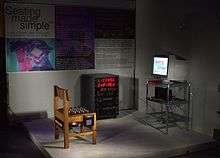Per-seat license
A Per-seat license is a software license model based on the number of individual users who have access to a digital service or product. For example, 50-user per-seat license would mean that up to 50 individually named users can access the program (named user licensing[1] ).
Per seat licensing is administered by providing user-level security to the directory containing the program. One alternative is the concurrent user license, based on the number of simultaneous users—regardless of which individuals they are—accessing the program. It typically deals with software running in the server where users connect via the network. For example, in a 50-user concurrent use license, after 50 users are logged on to the program, the 51st user is blocked. When any one of the first 50 logs off, the next person can log on. Concurrent licensing can be managed by the application itself or via independent software metering tools.
Per seat licensing often imposes restrictions on the users. A user may be a person, software or device accessing the software. User licenses may be differentiated by user types, as authorized users, external user, internal user, qualified user, etc. User types to be taken into account are determined by the licensing requirements.[2]
Per-seat licensing is common for products used by specialised professionals in industrial settings. In addition to computer programming, typical examples include chemists,[3] molecular biologists,[4] geographers,[5] and designers.[6]

Per-seat licensing usually only applies to intellectual property, but in February 2001, per-seat licensing was applied to the real-world as part of a traveling art installation at various museums and art galleries, starting with San Francisco Art Institute (SFAI).[7] In this exhibit, seating was equipped with retractable spikes, the spikes retracting when payment was inserted. Various licensing schemes were offered, including a floating license which would allow the owner of the license to sit on any ONE (i.e. not be able to share the seating license) of the Internet-connected chairs; the license only allowed one set of spikes to retract at-a-time, thus creating a floating license to real physical objects (e.g. seating, and various other physical objects).[8]
References
- Bontis, Nick; Chung, Honsan (2000). "The evolution of software pricing: from box licenses to application service provider models" (PDF). Internet Research. MCB UP Ltd. 10 (3): 246–255. doi:10.1108/10662240010331993. ISSN 1066-2243. Archived from the original on 2017-10-30. Retrieved 2017-10-30.
- "SAM And Licensing Glossary". OMT-CO Operations Management Technology Consulting GmbH. Retrieved 26 June 2013.
- "Finding an oasis in the desert of bioinformatics" Jeffrey Thomas and David K. Stone BIOSILICO v. 1, Issue 2, 2 May 2003, p. 56-58
- Anderle, Pascale; Duval, Manuel; Draghici, Sorin; Alan Roberts, Matthew (2003). "Gene expression databases and data mining" (PDF). BioTechniques. Suppl: 36–44. PMID 12664683. Archived (PDF) from the original on 2005-01-25. Retrieved 2017-10-30.
- Bivand, Roger; Gebhardt, Albrecht (2000). "Implementing functions for spatial statistical analysis using the R language" (PDF). Journal of Geographical Systems. 2 (3): 307–317. Bibcode:2000JGS.....2..307B. doi:10.1007/PL00011460. ISSN 1435-5930. Archived (PDF) from the original on 2017-10-30. Retrieved 2017-10-30.
- Knol, Stephen; Hauck, Scott (1998). "Data security for Web-based CAD" (PDF). Proceedings 1998 Design and Automation Conference. 35th DAC. 00: 788–793. doi:10.1109/DAC.1998.10030. Archived (PDF) from the original on 2017-10-30. Retrieved 2017-10-30.
- Leonardo 36(1), 2003, pp19-26, Leonardo/ISAST the International Society for the Arts, Sciences and Technology, MIT Press
- CA 2325569 (Canadian Patent)